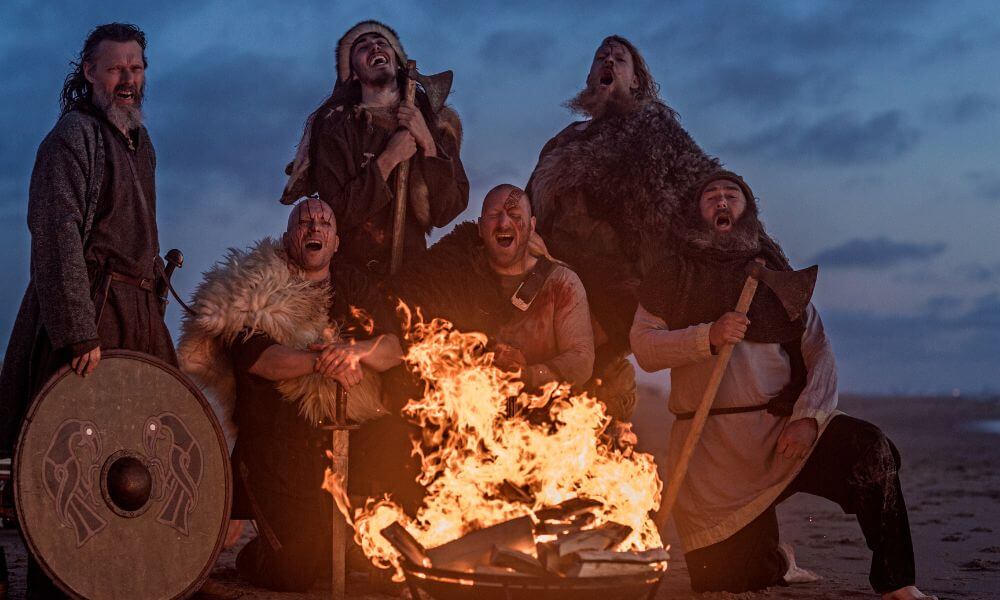Vikings is the name given to a population of seafaring people originally from Scandinavia. They are most commonly known for raiding various settlements and communities during their time. Theit earliest recorded raid is from 793 AD, and they survived until 1066 AD when the Normans invaded and conquered England. The Vikings spoke Old Norse, which evolved from Proto-Norse in the 7th century.
Old Norse was native to a number of different countries.
Firstly, it was spoken in the Scandinavian countries which is comprised of Norway, Sweden and Demark.
It was also spoken in Iceland, Faroe Island, Greenland and any other Norse settlements at the time.
Old Norse was a Germanic language and gave rise to a subset of other languages, six of which are still spoken today: Faroese, Icelandic, Norwegian, Danish, Swedish and Elfdalian.
The language stemmed from Proto-Norse. Proto languages are a hypothetical lost parent languages from which other languages are derived.
Proto-Norse is thought to have existed from the 2nd century AD to the 8th century AD.
Old Norse was written in Younger Futhark, the runic alphabet used by the Norsemen.
Proto-Norse was written in Elder Futhark.

Is the Viking Language Still Spoken Today?
No, the Viking Language, more commonly known as Old Norse, is not still spoken today.
However, there are Old Norse words that the English language has borrowed and adopted into its own lexicon.
The Elfdalian language spoken natively by fewer than 2,000 people is the closest surviving language to Old Norse.
What is Elfdalian?
Elfdalian is one of six surviving languages that evolved from Old Norse and by far the most obscure.
As of 2009, there were only around 2,000 native speakers and as such it is considered to be endangered.
Attempts are being made to try and preserve the language, with many calling for Sweden to recognize it as an official language.
It developed in relative isolation since the Middle Ages and has remained closer to Old Norse than other Dalecarlian dialects.
The language is spoken in the locality of Älvdalen located in the south-eastern part of the Älvdalen Municipality in northern Dalarna, Sweden.
What Texts Were Written in Old Norse?
Many of the Old Norse texts we have today come from Iceland with a smaller number coming from Scandinavia.
Icelandic literature is typically divided up into three parts: Eddic poetry, Sagas and Scaldic Poetry.
Eddic Poetry, or edda, is a poetry form containing mainly mythological stories and scenarios.
Some of the best known edda are the Poetic Edda, written in the late 10th century and the Prose Edda which dates to c. 1220.
Sagas were usually more reality-based and dealt with actual events.
Some of the best-known sagas are the Kings’ saga and the Icelanders’ saga.
Skaldic poetry was written to honour nobles and kings.
They were factual accounts and were composed by skalds, the well-known poets of the time.
These skalds were broken up into four different types: professional poets, private poets, clerics and anonymous poets.
What English Words Stemmed from Old Norse?
Just like the Vikings of old used to invade various settlements, the Viking language invaded the English language and there are many words we use today that have their origins in Old Norse.
For example, the term club comes from the Old Norse klubba, meaning a heavy, blunt weapon.
And the word ransack comes from rannsaka meaning to search a house.
For a longer, though incomplete, list of Old Norse words that have found their way into English see the list below:
| English | Old Norse | Meaning |
| Loan | Lán | To lend |
| Skill | Skil | Distinction |
| Bug | Búkr | An insect within trees |
| Bull | Boli | A bull |
| Reindeer | Hreindyri | A reindeer |
| Dirt | Drit | Excrement |
| Mire | Myrr | Bog |
| Call | Kalla | To cry loudly |
| Cast | Kasta | To throw |
| Clip | Klippa | To cut |
| Stain | Steina | To paint |
| Ball | Bǫllr | A round object |
| Knot | Knutr | A knot |
| Cake | Kaka | A cake |
| Egg | Egg | An egg |
| Freckles | Freknur | Freckles |
| Skin | Skinn | Animal hide |
What Was Proto-Norse?
Proto-Norse is the hypothesised parent language of Old Norse.
It was an Indo-European language that was spoken in Scandinavia and is thought to have evolved as a northern dialect of Proto-Germanic in the first century.
The Proto-Norse language is estimated to have been spoken between the 2nd and 8th centuries.
Proto-Norse goes by a variety of different names: Ancient Nordic, Ancient Scandinavian, Ancient Norse and so on.
Linguistically it is known as an attested language as there is surviving evidence for its existence.
The surviving evidence of Proto-Norse are all runic inscriptions in the Elder Futhark.
There are about 260 such inscriptions with the earliest dating back to the 2nd century.
What Was Elder Futhark?
Elder Futhark, also known as Older Futhark, Old Futhark or Germanic Futhark, is the oldest form of runic alphabet.
Inscriptions of the alphabet can be on artifacts such as jewellery, tools and weapons as well as runestones.
The Elder Futhark got its name from the phoneme of its first six letters: F, U, Þ, A, R and K.
The alphabet has a total of 24 runes that are traditionally arranged into three groups of eight, with each group called an ætt.
What Was Younger Futhark?
Younger Futhark, also known as Scandinavian Runes, is another runic alphabet and a simplified form of Elder Futhark.
The alphabet only features 16 characters as compared to Elder Futhark’s 24.
Linguists place the widespread use of the simplified alphabet from about the 9th century after first undergoing a transitional period in the 7th and 8th centuries.
Younger Futhark’s lifetime roughly corresponds with the Viking Age. Its use declined following the Christianization of Scandinavia from the 8th century to the 12th century, after which most Scandinavian writings was in the Latin alphabet.
Runic scripts did manage to survive in the form of medieval runes and Latinised Dalecarlian runes.
The Vikings were a seafaring people from Scandinavia best known for raiding and pillaging communities.
They spoke a language known as Old Norse which was written in the runic script, Younger Futhark.
The language is no longer spoken and the closest descendant we have today is Elfdalian, which comes from the locality of Älvdalen in Sweden.
There are many words in the English language that come from Old Norse such as club (klubba), reindeer (hreindyri) and cake (kaka).
More in Languages
- What Language Did Abraham Speak? (Explained!)
- What Language Did Adam And Eve Speak? (Answered!)
- What Language Did Albert Einstein Speak? (Wunderbar!)
- What Language Did Alexander The Great Speak? (Answered!)
- What Language Did Anne Frank Speak? (It May Surprise You!)
- What Language Did Beethoven Speak? (Revealed!)
- What Language Did Boudicca Speak? (Explained!)
- What Language Did Bruce Lee Speak? (Answered!)
- What Language Did Catherine The Great Speak? (Answered!)
- What Language Did Cavemen Speak? (Explained!)
- What Language Did Christopher Columbus Speak? (Answered!)
- What Language Did Cleopatra Speak? (Explained!)
- What Language Did George Washington Speak? (Revealed!)
- What Language Did Jesus Speak? (Answered!)
- What Language Did Julius Caesar Speak? (Find Out!)
- What Language Did Moses Speak? (Answered!)
- What Language Did Mozart Speak? (Answered!)
- What Language Did Noah Speak? (Explained!)
- What Language Did The Anglo Saxons Speak? (Answered!)
- What Language Did The Aztecs Speak? (Answered!)
- What Language Did The Buddha Speak? (Explained!)
- What Language Did The Vikings Speak? (Answered!)
- What Languages Are Spoken In Afghanistan? (Find Out!)
- What Languages Are Spoken In Africa? (Revealed!)
- What Languages Are Spoken In Albania? (Answered!)
- What Languages Are Spoken In America? (Answered!)
- What Languages Are Spoken In Antwerp? (Find Out)
- What Languages Are Spoken In Argentina? (Revealed!)
- What Languages Are Spoken In Australia? (Find Out!)
- What Languages Are Spoken In Austria? (Answered!)
- What Languages Are Spoken In Bangladesh? (Revealed!)
- What Languages Are Spoken In Barcelona? (Answered!)
- What Languages Are Spoken In Belgium? (Revealed!)
- What Languages Are Spoken In Bolivia? (Answered!)
- What Languages Are Spoken In Bosnia? (Answered!)
- What Languages Are Spoken In Brazil? (Find Out!)
- What Languages Are Spoken In Budapest? (Revealed!)
- What Languages Are Spoken In China? (Answered!)
- What Languages Are Spoken In Colombia? (Revealed!)
- What Languages Are Spoken In Croatia? (Answered!)
- What Languages Are Spoken In Cuba? (Revealed!)
- What Languages Are Spoken In Cyprus? (Revealed!)
- What Languages Are Spoken In Denmark? (Find Out!)
- What Languages Are Spoken In Djibouti? (Answered!)
- What Languages Are Spoken In Ecuador? (Find Out!)
- What Languages Are Spoken In Egypt? (Answered!)
- What Languages Are Spoken In El Salvador? (Answered!)
- What Languages Are Spoken In England? (Find Out!)
- What Languages Are Spoken In Estonia? (Revealed!)
- What Languages Are Spoken In Ethiopia? (Answered!)
- What Languages Are Spoken In Fiji? (Revealed!)
- What Languages Are Spoken In Japan? (Answered!)
- What Languages Are Spoken In Morocco? (Answered!)
- What Languages Are Spoken In South Africa? (Answered!)

